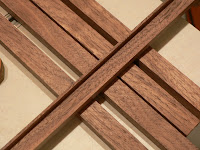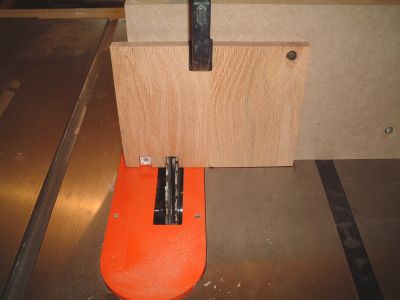Instruments built in the Italian tradition arrived at the proper bentside curvature by simply drawing a curve parallel to the soundboard bridge at a constant distance to the right. So determining the layout of the bentside is equivalent to deciding the bridge curvature, except that the bridge curvature must be highly accurate, while minor variances in the bentside are probably fine as long as everything looks good.
The bridge curvature is not too difficult to determine, as the string lengths through a large part of the compass are based on what is termed Pythagorean scaling. In a nutshell, this means that a string one octave lower than a given string is exactly twice as long, while a string an octave higher is half as long. This might sound quite obvious were it not for the fact that stringed instruments can be made without following this rule exactly. If you wanted to use a lower string less than twice as long, you could choose thicker wire to compensate. Likewise, if a higher string were more than twice as long, additional tension would bring it to the proper pitch.
Other string lengths within the octave are determined using simple whole-number ratios derived from the overtone series. Some examples:
a major 2nd = 8:7
a minor 3rd = 6:5
a major 3rd = 5:4
a perfect 4th = 4:3
a diminished 5th = 7:5
a perfect 5th = 3:2
a major sixth = 5:3
a minor 7th = 7:4
a perfect octave = 2:1 (obviously)
With these ratios, it is in fact possible to specify the length of just one string, fill in the remainder of the octave as above, then start doubling and halving string lengths from there. The one string so specified is called the scale and is usually c above middle c (c'', in Helmholtz notation). The original Trasuntino has a scale of c''=276 mm, which my friendly harpsichord maker advised me to shorten slightly to c''=273 mm. This provides a safety margin in case of major swings in humidity, as well as some protection against "ham-fisted tuning", as he put it (I'm pretty sure he wasn't talking about me). A marginally shorter scale means the instrument doesn't need to be pulled up to quite as high an operating tension as the original, as all the strings are a bit shorter. The home pitch will be A=415 Hz, with the keyboard transposing one semitone to the right.
Instead of the simple ratios above, one can approximate a Pythagorean string scaling fairly well by calculating the string lengths according to an equal-tempered scale. In that case, one multiplies successively by the twelfth root of 2 to find the next lower string, and divides by the twelfth root of 2 to find the next higher string. That's what I've done in making my calculations.
One thing to be aware of is that Pythagorean scaling in Italian instruments usually doesn't determine the entire compass, especially in the bass: if it did, the instrument would have to be quite long to accommodate the bass strings. Often the scaling is Pythagorean from the very top down to c below middle c (c), or, less often, for still another octave (C). The scaling must then alter, in any case, because most instruments have a joint in the bass bridge where it goes off to the left at a sharp angle for the last couple of notes.
My drawing of the Trasuntino has string lengths for all c and f# notes (f# is right in the middle of octave). The scale is pretty close to Pythagorean, but not bang-on. This could be due to the fact that the instrument has been rebuilt several times in the course of its existence. The manner of placing the bridge on the soundboard—it just gets bent to shape by hand and glued down—might introduce minor discrepancies as well. In any case, I calculated a Pythagorean scaling down to c quite easily, then spent the rest of the day thinking about the bass strings and their departure from this pure scale. Eventually I put down some provisional numbers based on the shrinking octave ratios in the bass (it goes to 1.922, 1.712 and so on).
Here is the procedure for laying out the curvature of the bridge on the bottom. First, I clamped one of my registers along the pencil line showing the back of the wrestplank:

This line is at an 8 degree angle and of course the register slot spacing is correct only when tilted to this angle. I put the register on edge because the bottom of each slot provides a convenient edge for my pencil to make a tick mark.
I didn't just lay the register down anywhere along this line. In looking at the drawing, I saw that the leftmost string was 30 mm from the left edge of the instrument. I decided to put my first string at 35 mm, because I'm making my instrument a bit wider. Before committing to this, I located where the first and last strings would be with respect to the leftmost and rightmost slots (about 5 or 6 mm to the side, roughly), to make sure they didn't get placed inconveniently. When everything looked good, I put a pencil tick at 35 mm and aligned the left edge of the first register slot with it before clamping.
After that, it was simply a matter of counting along the slots and putting tick marks on each c and f#. This took only a minute:

Next, I laid my home-made T-square along the baseboard and aligned the left edge with each tick mark in turn. Using a tape measure, I measured out the lengths of the c and f# strings I had already calculated and put a second tick mark on the baseboard in line with the first:

The T-square has a small nail that lines up with the nut location to hold the tape measure. This nail position is fixed because the Trasuntino's nut is straight and perpendicular to the left side. In any other instrument, the nail would have to be repositioned every time the T-square was moved.
Once all the measurements were made, I drove a 1.5" finishing nail into each second tick mark location. Then I bent a long strip of door stop composite (some sort of plastic; very cheap and a nice balance between stiff and flexible) along the nails and held it in place with spring clamps:

And that is how the bridge curvature looks. The actual bentside will be about 4" away from this. I set my dividers to 4" and got a sense of what this might look like by lightly running the dividers along the strip without making a mark. When the time comes to mark for real, I'll run a small engineer's square along the strip and place a compass set to 4" along the edge. This will accurately transfer the curve.
I should point out that the bridge position in the extreme bass is not accurately shown by the plastic strip. The furthest nail is properly placed, but the bridge does not run in a straight line to it. Instead, slightly behind the second-last clamp, the bridge keeps curving to the right and then hooks left to meet the nail.
The tail position is straightforward: at the point where the actual bentside width shrinks to 185 mm (the same width as the bass end of the wrestplank, which is unlikely to be a coincidence), the bentside ends and the tail goes off to the left at a 40-degree angle.





















